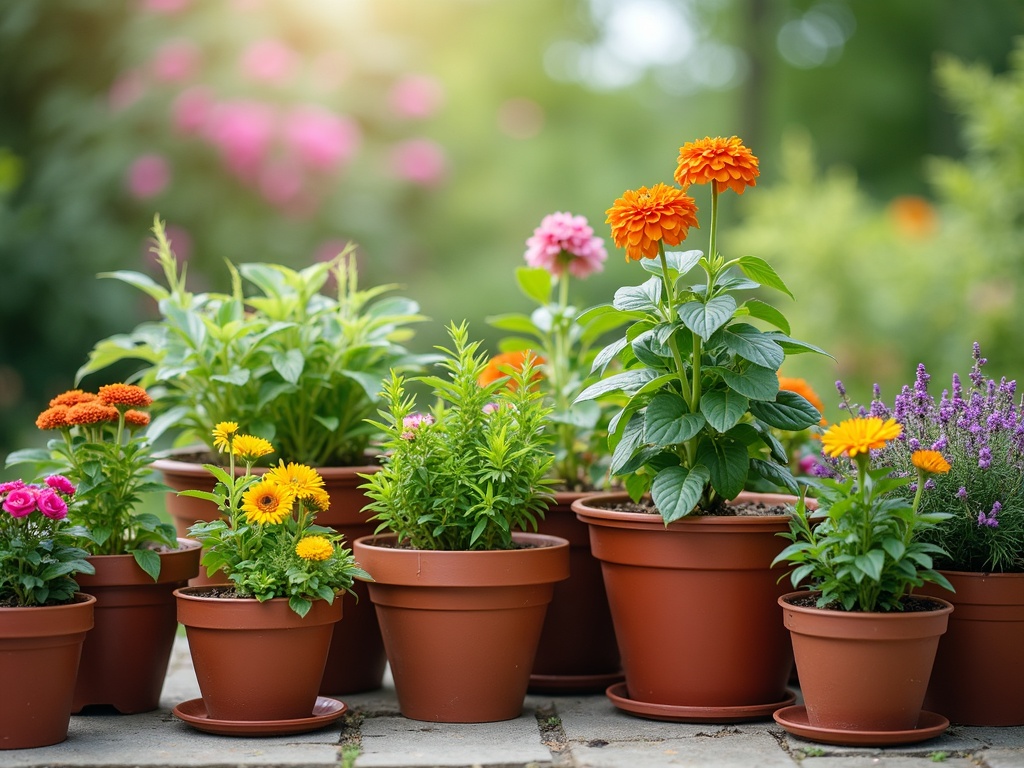Container Gardening Essentials: A Comprehensive Guide
Imagine vibrant blooms cascading from a balcony, fresh herbs scenting your patio, or a miniature vegetable garden thriving on your city rooftop. Container gardening makes this all possible, transforming any space into a verdant oasis. But before you grab a bag of potting soil and a handful of seeds, let’s explore the essential tools and techniques for creating a flourishing container garden.
Choosing the Right Containers
The foundation of any successful container garden lies in selecting the appropriate pots. While aesthetics are important, consider these practical factors:
- Material: Terracotta pots are classic and breathe well, but can dry out quickly. Plastic pots are lightweight and retain moisture but may not be as visually appealing. Resin and fiberglass offer a good balance of durability and aesthetics.
- Size: Bigger is generally better, especially for plants with extensive root systems. Ensure the container is large enough to accommodate the mature size of your chosen plants.
- Drainage: Excellent drainage is crucial to prevent root rot. Make sure your containers have drainage holes, and consider adding a layer of gravel or broken pottery at the bottom to improve drainage.
- Weight: Remember that soil and water add significant weight, especially in larger containers. Consider the weight capacity of your balcony or patio before choosing heavy materials like concrete.
Popular container choices include:
- Terracotta pots: Classic look, good drainage, but can dry out quickly.
- Plastic pots: Lightweight, affordable, retain moisture well.
- Resin pots: Durable, weather-resistant, various styles available.
- Metal containers: Stylish, but can heat up quickly in direct sunlight.
- Hanging baskets: Ideal for trailing plants and flowers.
- Self-watering containers: Convenient for busy gardeners, provide consistent moisture.
Selecting the Right Soil
Using garden soil in containers is a common mistake. Garden soil compacts easily, hindering drainage and airflow, which can lead to root problems. Instead, opt for a high-quality potting mix specifically formulated for container gardening. These mixes are typically lightweight and well-draining, containing ingredients like:
- Peat moss or coir: Helps retain moisture and provides aeration.
- Perlite or vermiculite: Improves drainage and aeration.
- Compost: Adds nutrients and beneficial microbes.
For specific plants, you might need specialized mixes. For example, succulents and cacti thrive in a well-draining mix with added sand, while acid-loving plants like blueberries benefit from a mix formulated for acidic conditions.
Essential Tools for Container Gardening
While container gardening doesn’t require a vast array of tools, having a few essentials on hand will make the process easier and more enjoyable:
- Trowel: For digging, transplanting, and scooping soil.
- Hand rake: For smoothing soil and removing debris.
- Watering can or hose: For watering your plants. A watering can with a long spout is ideal for reaching plants in hanging baskets.
- Pruning shears: For trimming and deadheading plants.
- Gardening gloves: To protect your hands.
- Soil testing kit: To monitor the pH and nutrient levels of your soil.
Choosing the Right Plants
Not all plants thrive in containers. When selecting plants for your container garden, consider these factors:
- Sunlight: Choose plants that are suited to the amount of sunlight your container garden receives. Check seed packets or plant tags for sunlight requirements (full sun, partial shade, full shade).
- Size: Select plants that won’t outgrow their containers too quickly. Consider the mature size of the plant and choose a container that is appropriately sized.
- Water requirements: Group plants with similar water needs together to make watering easier.
- Growth habit: Consider the growth habit of the plant (e.g., upright, trailing, bushy) and choose plants that complement each other.
- Compatibility: Some plants thrive together, while others compete for resources. Research companion planting to find combinations that benefit each other.

Examples of plants that thrive in containers include:
- Vegetables: Tomatoes, peppers, lettuce, herbs.
- Flowers: Petunias, geraniums, impatiens, pansies.
- Fruits: Strawberries, blueberries, dwarf citrus trees.
- Herbs: Basil, mint, rosemary, thyme.
- Succulents: Echeveria, sedum, aloe.
Watering Techniques
Proper watering is crucial for the success of your container garden. Containers tend to dry out more quickly than garden beds, so regular watering is essential, especially during hot weather.
- Check the soil moisture: Before watering, check the soil moisture by sticking your finger about an inch into the soil. If the soil feels dry, it’s time to water.
- Water thoroughly: When watering, water deeply until water drains out of the drainage holes. This ensures that the roots are adequately hydrated.
- Water in the morning: Water in the morning to allow the foliage to dry before nightfall, which can help prevent fungal diseases.
- Avoid overwatering: Overwatering can lead to root rot. Allow the soil to dry out slightly between waterings.
- Use a watering can or hose with a gentle spray: Avoid using a strong jet of water, which can damage delicate plants and erode the soil.
Fertilizing Your Container Garden
Container plants rely on you to provide them with the nutrients they need to thrive. Regular fertilization is essential to ensure healthy growth and abundant blooms or harvests.
- Choose a fertilizer: Use a balanced, water-soluble fertilizer specifically formulated for container plants.
- Follow the instructions: Apply fertilizer according to the instructions on the label.
- Fertilize regularly: Fertilize your plants every 2-4 weeks during the growing season.
- Consider slow-release fertilizers: Slow-release fertilizers provide a steady supply of nutrients over a longer period of time.
- Organic options: Consider using organic fertilizers like compost tea or fish emulsion.
Dealing with Pests and Diseases
Container gardens are susceptible to the same pests and diseases as traditional gardens. Regularly inspect your plants for signs of problems and take action promptly.
- Identify the problem: Identify the pest or disease before taking action.
- Handpicking: Handpick pests like aphids and caterpillars.
- Insecticidal soap: Use insecticidal soap to control soft-bodied pests like aphids, whiteflies, and spider mites.
- Neem oil: Neem oil is an effective organic insecticide and fungicide.
- Fungicides: Use fungicides to treat fungal diseases like powdery mildew and black spot.
- Good air circulation: Ensure good air circulation to help prevent fungal diseases.
- Remove infected foliage: Remove and dispose of infected foliage to prevent the spread of disease.
Pruning and Deadheading
Regular pruning and deadheading will keep your container garden looking its best and encourage new growth and blooms.
- Pruning: Prune plants to maintain their shape and size, and to remove dead or damaged branches.
- Deadheading: Deadhead spent flowers to encourage new blooms. Simply pinch off the flower head just below the first set of leaves.
- Pinching: Pinch back the tips of stems to encourage bushier growth.
Extending the Growing Season
With a little planning, you can extend the growing season of your container garden.
- Start seeds indoors: Start seeds indoors several weeks before the last frost to get a head start on the growing season.
- Use cold frames or hoop houses: Protect your plants from frost with cold frames or hoop houses.
- Choose cold-hardy plants: Select plants that can tolerate cooler temperatures.
- Move containers indoors: Move containers indoors during the winter months to protect them from freezing temperatures.
Container Gardening Ideas and Inspiration
The possibilities for container gardening are endless. Here are a few ideas to get you started:
- Herb garden: Create a fragrant herb garden on your windowsill or balcony.
- Salad garden: Grow your own salad greens in a container garden.
- Vertical garden: Create a stunning vertical garden on a wall or fence.
- Succulent garden: Create a low-maintenance succulent garden in a container.
- Container water garden: Create a miniature water garden in a container.
Troubleshooting Common Problems
Even with the best care, you may encounter some problems in your container garden. Here are some common issues and how to address them:
- Yellowing leaves: Can be caused by overwatering, underwatering, nutrient deficiencies, or pests.
- Wilting: Can be caused by underwatering, heat stress, or root problems.
- Leggy growth: Can be caused by insufficient sunlight.
- Lack of blooms: Can be caused by insufficient sunlight, over-fertilizing, or improper pruning.
- Pests: Identify the pest and take appropriate action.
- Diseases: Identify the disease and take appropriate action.
Container gardening offers a rewarding way to connect with nature, even in the smallest of spaces. With careful planning, the right tools, and a little patience, you can create a thriving container garden that brings beauty and bounty to your life. So, gather your container gardening essentials and get ready to transform your space into a green paradise.
